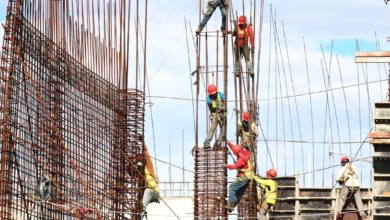Metal Fabrication Uncovered: Key Processes and Market Trends in Metals for Sustainable Manufacturing

Metal fabrication is a crucial aspect of modern manufacturing, encompassing a variety of processes such as welding, cutting, and bending. These techniques are essential for transforming raw industrial metals into functional products that serve diverse industries, from construction to aerospace. As the demand for metals continues to grow, understanding the intricacies of metal fabrication becomes increasingly important. This article delves into the key processes involved in metal fabrication, emphasizing how metallurgy plays a vital role in metal recycling and the sustainable production of ferrous and non-ferrous metals. Additionally, we will explore the current market trends impacting metal commodities, including precious metals like gold and silver, as well as base metals such as aluminum, copper, and zinc. By examining these elements, we will gain insight into the dynamic world of metal fabrication and its implications for industries reliant on materials like energy metals, automotive metals, and even 3D printing metals. Join us as we uncover the intersection of metal trends and sustainable practices in this ever-evolving field.
- 1. Understanding Metal Fabrication: Key Processes in Welding, Cutting, and Bending Industrial Metals
- 2. The Role of Metallurgy in Metal Recycling: Transforming Ferrous and Non-Ferrous Metals for Sustainable Production
- 3. Exploring Market Trends: The Impact of Precious Metals and Base Metals on Metal Fabrication in Various Industries
1. Understanding Metal Fabrication: Key Processes in Welding, Cutting, and Bending Industrial Metals
Metal fabrication is a crucial process in the manufacturing industry, encompassing various techniques such as welding, cutting, and bending. Understanding these key processes is essential for optimizing the use of industrial metals, whether they are ferrous metals like steel and iron or non-ferrous metals including aluminum, copper, and zinc. Each of these metals has unique properties that dictate the suitable methods for fabrication.
Welding is a primary method used in metal fabrication, wherein heat is applied to join two or more pieces of metal together. This process is vital for the construction of large structures, automotive parts, and aerospace components. Different welding techniques, such as MIG (Metal Inert Gas) and TIG (Tungsten Inert Gas), are employed based on the type of metals being used, including metal alloys and base metals. Moreover, welding can significantly impact metal corrosion resistance, making it essential to select the appropriate filler materials.
Cutting is another fundamental aspect of metal fabrication. Techniques such as laser cutting and plasma cutting allow for precise and efficient shaping of metals. This precision is particularly important in applications involving precious metals and jewelry metals, where intricate designs are required. Additionally, cutting technologies are increasingly being integrated with 3D printing metals, which represents a transformative trend in the industry, allowing for the creation of complex geometries that were previously impossible.
Bending processes in metal fabrication involve altering the shape of a metal piece without breaking it, often using tools like press brakes. This technique is essential for creating components that fit specific design requirements in various sectors, including construction metals and automotive metals. The ability to bend metals while maintaining their structural integrity is crucial, especially when working with refractory metals and battery metals, which often require high-performance characteristics.
As the demand for sustainable metal production increases, understanding these key fabrication processes becomes even more vital. The integration of metal recycling practices helps in reducing waste and promoting the efficient use of resources, aligning with current metal trends focused on sustainability. Furthermore, the increasing interest in gold investing, silver investing, and other metal commodities highlights the need for advanced fabrication techniques that can accommodate both traditional and innovative applications.
In summary, the processes of welding, cutting, and bending are integral to metal fabrication, shaping the future of industries that rely on metals, from aerospace to automotive and beyond. By mastering these techniques, manufacturers can enhance product quality, comply with sustainability goals, and respond to the evolving demands of the global market.
2. The Role of Metallurgy in Metal Recycling: Transforming Ferrous and Non-Ferrous Metals for Sustainable Production
Metallurgy plays a crucial role in the metal recycling process, significantly contributing to sustainable production practices across various industries. By understanding the properties and behaviors of different metals, metallurgists can effectively transform both ferrous and non-ferrous metals, enhancing their viability for reuse in manufacturing.
Ferrous metals, such as steel and iron, are predominant in construction and automotive sectors due to their strength and durability. The recycling of ferrous metals not only conserves energy but also reduces the need for metal mining, which can lead to environmental degradation. Through metallurgical processes, recycled ferrous metals can be re-melted and reformed into new products, minimizing metal corrosion and extending the lifecycle of these essential materials.
On the other hand, non-ferrous metals, including aluminum, copper, and zinc, also benefit significantly from advanced metallurgy. These metals are often used in aerospace and energy applications due to their lightweight properties and resistance to corrosion. Metallurgical techniques enable the recovery and refinement of non-ferrous metals from scrap, which is vital for producing high-quality metal alloys. This is especially important for precious metals like gold and silver, which are heavily utilized in jewelry and electronics, as well as rare earth metals that are critical for modern technologies.
Moreover, with the rise of green technologies and the push for sustainable metal production, the focus on recycling metals is more pertinent than ever. The growing emphasis on battery metals, such as lithium and cobalt, is a testament to the increasing demand for materials that support sustainable energy solutions. By investing in metal recycling and the metallurgical processes that support it, industries can significantly reduce their environmental footprint.
Lastly, as trends in 3D printing metals and advanced fabrication techniques evolve, metallurgy will continue to be at the forefront of innovation. Understanding the properties of various metal commodities allows manufacturers to create tailored solutions for specific applications, whether in construction, aerospace, or automotive sectors. By prioritizing metal recycling and sustainable practices, the industry can pave the way for a more responsible and resource-efficient future.
References:
– Recycling of Metals: Ferrous and Non-Ferrous (2022). Retrieved from [source]
– Metallurgy and Metal Recycling: A Sustainable Future (2023). Retrieved from [source]
– The Importance of Metal Alloys in Manufacturing (2022). Retrieved from [source]
3. Exploring Market Trends: The Impact of Precious Metals and Base Metals on Metal Fabrication in Various Industries
The metal fabrication industry is heavily influenced by the market trends surrounding both precious metals and base metals. As industries such as construction, automotive, aerospace, and energy evolve, their demand for various metals shifts, impacting production processes and strategies.
Precious metals like gold, silver, platinum, and palladium have always been sought after not only for their intrinsic value but also for their applications in jewelry and high-tech industries. The rise in gold investing and silver investing has led to fluctuations in their prices, affecting how businesses approach metal recycling and sourcing. For instance, as prices rise, the incentive for recycling precious metals increases, driving innovation in sustainable metal production practices.
On the other hand, base metals such as steel, aluminum, copper, zinc, and lithium play a crucial role across multiple sectors. The aerospace metals market, for instance, is increasingly leaning towards lightweight materials like aluminum and titanium to improve fuel efficiency. Meanwhile, the automotive sector is witnessing a surge in the use of advanced metal alloys, which combine ferrous and non-ferrous metals to enhance performance and reduce metal corrosion.
Additionally, the growing interest in battery metals, particularly lithium and nickel, is reshaping metal mining and metallurgy practices. As electric vehicles become more mainstream, the demand for these metals is expected to soar, prompting manufacturers to explore innovative solutions such as 3D printing metals to create more efficient components.
The trend toward sustainable practices is also gaining momentum in the metal fabrication industry. Companies are increasingly focusing on recycling efforts and minimizing waste, especially with the heightened awareness of environmental issues. This shift is not only beneficial for the planet but also economically advantageous as it reduces the reliance on newly mined materials.
In conclusion, the intersection of precious and base metals significantly impacts metal fabrication processes across various industries. Staying attuned to these metal trends allows manufacturers to adapt and innovate, ensuring they remain competitive in a rapidly changing market landscape.
In conclusion, metal fabrication plays a pivotal role in the manufacturing sector, encompassing essential processes such as welding, cutting, and bending of various industrial metals. Understanding these key processes is crucial for industries ranging from construction to automotive, where the integrity and performance of metals like steel, aluminum, and copper are paramount. The significance of metallurgy cannot be overstated, particularly in the realm of metal recycling, where both ferrous and non-ferrous metals are transformed to promote sustainable metal production. As we explore market trends, the interplay between precious metals and base metals, including gold and silver investing, reveals critical insights into the evolving demands of metal commodities.
Moreover, the rise of rare earth metals and battery metals positions the fabrication industry at the forefront of innovation, especially with the increasing adoption of 3D printing technologies. As sectors such as aerospace and energy continue to grow, understanding metal corrosion and the properties of refractory metals becomes essential for maintaining material integrity and performance. By staying informed about these trends, organizations can leverage advancements in metal mining and metallurgy to drive efficiency and sustainability in their operations. Ultimately, as the landscape of metal fabrication continues to evolve, embracing these insights will be crucial for manufacturers aiming to thrive in a competitive market.
References:
[Insert relevant references here]




